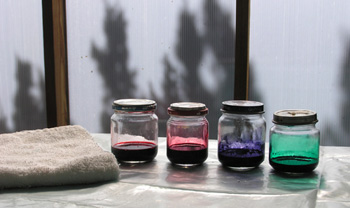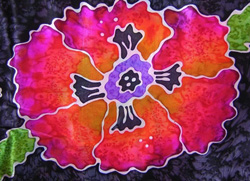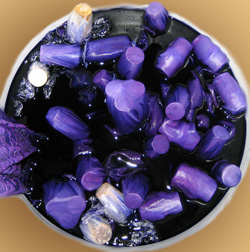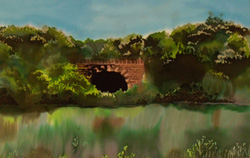Techniques
New Mexico Silk Painters Guild members use various materials and techniques to turn cloth into art. Salt, alcohol, urea. and sugar are among the list of houshold supplies we manipulate to create textural effects on the painted surface. Embossing or etching silk/rayon velvet, silk screening, stamping, stenciling of resists or thickened dye, discharge dyeing to lighten or subtract color, immersion dyeing plus various batik and shibori techniques are just a few creative methods we use in our search for personal expression in painting and dyeing cloth.
Following are brief descriptions of some of these techniques.   |
Dyes:
 Acid dyes are typically used on protein fibers such as silk. They may be applied with a brush or thickened and stamped on the fabric. They are usually set by steaming, but may be set in a microwave (with care). Acid dyes are typically used on protein fibers such as silk. They may be applied with a brush or thickened and stamped on the fabric. They are usually set by steaming, but may be set in a microwave (with care).
Fiber-reactive dyes are used on vegetable fibers such as cotton, rayon, and hemp, but also work on silk. They are often used in dyebaths and low immersion applications, but may be applied directly with brushes and stamps. Sufficient time, correct pH, correct temperature, and moisture are required to set them. |
Gutta Resist
Gutta is usually applied with a squeeze bottle with a metal tip. The resulting line forms a “dam” which holds the liquid dye within its boundaries. This is a basic silk painting technique which is taught by many of our members (see Workshops). |
  Here, gutta was used to draw the design, which was then painted with liquid dye and salted while the dye was still damp. Here, gutta was used to draw the design, which was then painted with liquid dye and salted while the dye was still damp.
© Sue Orchant |
Salt and Alcohol
Table salt, stock salt, rock salt, and even sugar give interesting and somewhat unpredictable patterns when sparingly sprinkled onto fabric while the dye is still damp.
Alcohol can also be used to move acid dye on silk before it is set. |
  Patterns made by sprinkling stock salt on damp dye. After the dye was dry, alcohol was used to further manipulate the dye. Patterns made by sprinkling stock salt on damp dye. After the dye was dry, alcohol was used to further manipulate the dye.
© Bunny Bowen |
Shibori
Shibori is a Japanese word which includes a number of different mechanical resist techniques, including binding with cord or string, clamping, stitching, and knotting. Several of our members teach these (see Workshops). |
  Shibori done with silk tied around wine corks, which float in purple fiber-reactive dye. Shibori done with silk tied around wine corks, which float in purple fiber-reactive dye.
© Bunny Bowen |
Wax Resist (Batik)
Some of our members use paraffin, beeswax, and soy wax as a resist. Click here to view a brief demonstration of one way to use wax as a resist. |
  Here soywax was used to resist acid dyes on silk. Soywax can usually be removed by washing in warm water and mild soap, so it is considered less of an environmental hazard than waxes which require dry cleaning for removal. Here soywax was used to resist acid dyes on silk. Soywax can usually be removed by washing in warm water and mild soap, so it is considered less of an environmental hazard than waxes which require dry cleaning for removal.
© Mildred Woodrow |
